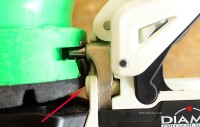We’ve been encountering quite a few newcomers to our sport, both online and in person. More the better we say! Here is a list for you all:
0. Ski touring is all about walking uphill. If you do not enjoy walking uphill, you will not enjoy ski touring.
1. Tech bindings are the way, frame bindings are klunky junk. “Tech” bindings are ski bindings with the “Dynafit” configuration that sticks two tiny pins into special boot fittings at toe and heel.
2. Dynafit is pronounced two ways: “Deeee-na-fit” & “Diiiii-na-fit.” If you’re dealing with well seasoned individuals or experienced ski shop folks, either pronunciation is okay.
3. You don’t need adjustable ski poles. But if you want, by all means feel free as they can be handy.
4. Any avalanche beacon currently available works fine if you practice with it. If you don’t practice several times a season, any avalanche beacon currently available is at best a statement of how self centered you are.
5. Airbag avalanche balloon packs are worth sporting if you ski in avalanche terrain. Buy a pack that allows you to practice a few inflations a year. Electronic packs may be the way of the future, but the lightest weight are currently European models configured with carbon fiber gas cylinders.
6. While going uphill, you’ll need much less clothing than you generally use while resort skiing. Layering is key, and consider pants that are trimmer than an Airbus — there is only one of you in there, not you and three special friends.
7. Especially while learning, beware of large groups. Best to ski with just a couple of other people who you’re comfortable with as mentors.
8. Next to bindings, special boots are what makes ski touring work. If you get lighter ones they’ll feel different than your alpine boots. Embrace the feeling, get out and practice.
9. Carry a good shovel specifically made for avalanche rescue, learn how to stow it inside your backpack instead of with the handle sticking up like a telephone pole.
10. Gear shopping can be overwhelming and expensive. Get to know your local consignment shop and don’t be afraid of Ebay.
11. Getting familiar with your gear by uphilling at resorts is alright. Could even be a way to make friends.
12. Goggles are often best left in a case, in your backpack, until needed for the downhill. But always bring them.
13. Helmets are okay, use a net or other carrying device on you backpack, don’t let it just dangle and fill with snow. Wear your hardhat while skiing down — there is nothing weirder than seeing a person skiing downhill with a helmet swinging from their backpack. Consider wearing your helmet all the time, up and down.
14. Know first aid. Take a course if necessary.
15. Likewise, know what an avalanche is and how it happens — take an avalanche safety course.
While most of the WildSnow backcountry skiing blog posts are best attributed to a single author, some work well as done by the group.

